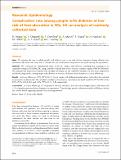Complication rate among people with diabetes at low risk of foot ulceration in Fife, UK : an analysis of routinely collected data
Abstract
Aims To estimate the rate at which people with diabetes and a low risk of foot ulceration change diabetic foot ulceration risk status over time, and to estimate the rate of ulceration, amputation and death among this population. Methods We conducted an observational study of 10 421 people with diabetes attending foot screening in an outpatient setting in NHS Fife, UK, using routinely collected data from a national diabetes register, NHS SCI Diabetes. We estimated the proportion of people who changed risk status and the cumulative incidence of ulceration, amputation and death, respectively, among people with diabetes at low risk of diabetic foot ulceration at 2‐year follow‐up. Results At 2‐year follow‐up, 5.1% (95% CI 4.7, 5.6) of people with diabetes classified as low risk at their first visit had progressed to moderate risk. The cumulative incidence of ulceration, amputation and death was 0.4% (95% CI 0.3, 0.6), 0.1% (95% CI 0.1, 0.2) and 3.4% (95% CI 3.1, 3.8), respectively. Conclusions At 2‐year follow‐up, 5% of people at low risk of diabetic foot ulceration changed clinical risk status and <1% of people experienced foot ulceration or amputation. These findings provide information which will help to inform the current debate regarding optimal foot screening intervals.
Citation
Heggie , R , Chappell , F , Crawford , F , Martin , A , Gupta , S , Hawkins , N , Horne , M , Leese , G P & Lewsey , J 2020 , ' Complication rate among people with diabetes at low risk of foot ulceration in Fife, UK : an analysis of routinely collected data ' , Diabetic Medicine , vol. 37 , no. 12 , pp. 2116-2123 . https://doi.org/10.1111/dme.14339
Publication
Diabetic Medicine
Status
Peer reviewed
ISSN
0742-3071Type
Journal article
Description
This project was funded by the National Institute for Health Research (NIHR) Health Technology Assessment Board (project no: HTA 15/171/01).Collections
Items in the St Andrews Research Repository are protected by copyright, with all rights reserved, unless otherwise indicated.

